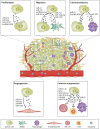Non-coding RNAs shuttled via exosomes reshape the hypoxic tumor microenvironment
- PMID: 32503591
- PMCID: PMC7275461
- DOI: 10.1186/s13045-020-00893-3
Non-coding RNAs shuttled via exosomes reshape the hypoxic tumor microenvironment
Abstract
Exosomes are small extracellular vesicles secreted by almost all the cells. Molecular cargos of exosomes can partially reflect the characteristics of originating cells. Exosome-mediated cell-to-cell interactions in the microenvironment are critical in cancer progression. Hypoxia, a key pro-cancerous feature of the tumor microenvironment, alters the releasing and contents of exosomes. A growing body of evidence shows that hypoxia induces more aggressive phenotypes in cancer. Of note, non-coding RNAs shuttled in hypoxic tumor-derived exosomes have been demonstrated as fundamental molecules in regulating cancer biology and remodeling tumor microenvironment. Furthermore, these hypoxic tumor-derived exosomal non-coding RNAs can be detected in the body fluids, serving as promising diagnostic and prognostic biomarkers. The current review discusses changes in cancer behaviors regulated by exosomes-secreted non-coding RNAs under hypoxic conditions.
Keywords: Exosomes; Hypoxia; LncRNA; MiRNA; Non-coding RNA; Tumor microenvironment.
Conflict of interest statement
The authors declare that they have no competing interests.
Figures



References
Publication types
MeSH terms
Substances
LinkOut - more resources
Full Text Sources
Medical

